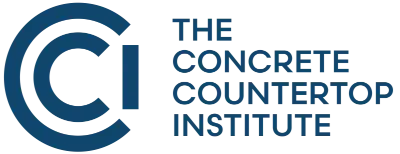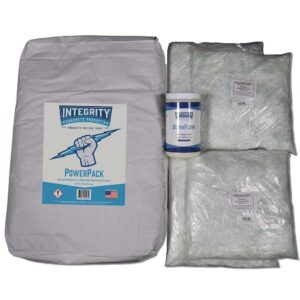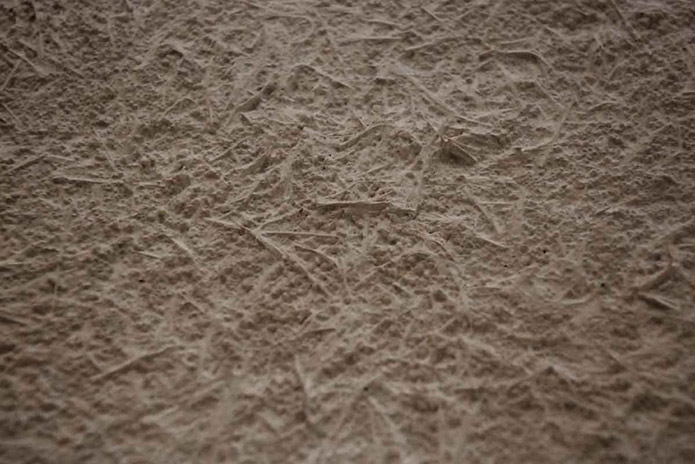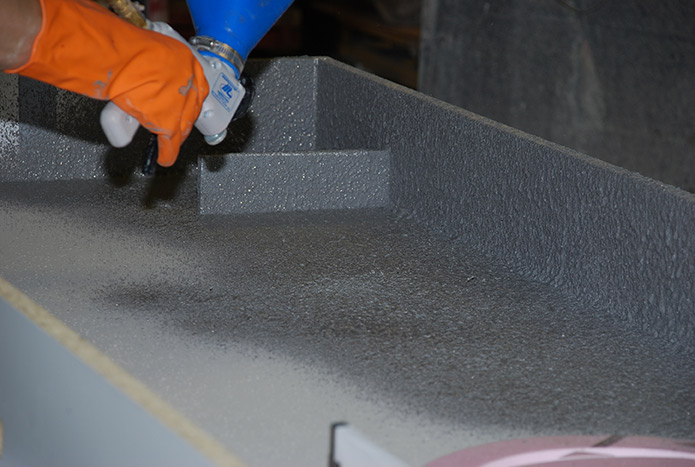What is GFRC?
GFRC, or Glass Fiber Reinforced Concrete, is a versatile, high-performance concrete mix that incorporates alkali-resistant glass fibers to produce a material with exceptional strength and reduced weight. Widely used in architectural applications such as building cladding, GFRC concrete is an ideal choice for countertops, wall panels, and custom concrete surfaces.
By combining concrete with glass fibers, GFRC offers unique benefits over traditional concrete, from added durability to design flexibility.
Applications of GFRC Blended Mix
This innovative material can be applied in a variety of ways to suit different project needs:
- Sprayed: Ideal for creating thin, yet strong, surfaces and intricate designs.
- Poured: Perfect for seamless, uniform structures such as countertops and large panels.
- Pressed: Offers a unique finish and texture, adding an artistic touch to any project.
- Troweled: Ensures precision and a smooth finish, ideal for detailed work.
By utilizing these methods, GFRC provides unmatched versatility, making it a top choice for modern construction and design projects.
Why Choose GFRC Concrete?
Here are some standout benefits of the preferred choice for projects requiring lightweight yet robust materials:
-
Design Flexibility
GFRC concrete can be molded into a variety of shapes, textures, and finishes, allowing designers and fabricators to create unique surfaces that align with aesthetic goals without sacrificing durability.
-
Lightweight Composition
Compared to traditional concrete, GFRC is up to 75% lighter. This makes GFRC concrete ideal for large, intricate designs where weight is a concern, such as countertops, sculptures, and architectural panels.
-
Durability in Diverse Environments
GFRC withstands environmental stress, including moisture, temperature changes, and UV exposure, making it an ideal option for indoor and outdoor applications alike.
-
Enhanced Flexural and Tensile Strength
The glass fibers embedded in GFRC create a durable matrix that provides superior flexural and tensile strength, reducing the likelihood of cracks and breakage over time.
What types of projects is GFRC suited for?
GFRC was developed for architectural concrete and manufacturing architectural products such as: wall panels, window surrounds, column covers, soffits, cornices, brackets, quoins, railings, pilasters, copings, domes, site furnishings, planters, bollards, urns and tables. In recent decades, it has become the material of choice for creative concrete applications such as countertops, furniture, sinks, fire pits, fireplace surrounds, decorative wall panels and more.
Just like regular concrete, GFRC can accommodate a variety of artistic embellishments including acid staining, dying, integral pigmentation, decorative aggregates, veining and more. It can also be etched, polished, sandblasted and stenciled. If you can imagine it, you can do it, making GFRC a great option for creating concrete countertops and especially three-dimensional concrete elements.
Here are just a few of the amazing applications of GFRC in the realm of creative concrete:
Key Components of GFRC: What’s in the Mix?
Understanding the ingredients in GFRC is essential for creating a high-quality final product. A typical GFRC mix includes the following components:
-
High-Quality Cement and Fine Sand
A well-balanced mix includes Portland cement and fine sand, often at a 1:1 ratio, to ensure a smooth texture. Fine sand (#50-#30 sieve) is ideal for consistency and surface finish. Click here for more information about the best sand for GFRC.
-
Acrylic Polymer
Add polymers to enhance flexibility and reduce shrinkage. Acrylic polymers are especially beneficial as they offer UV stability, resist yellowing, and provide excellent bonding properties. Click here for more information about polymer.
-
AR Glass Fibers
Use alkali-resistant glass fibers to reinforce the concrete matrix, making it stronger and more resilient to cracking and environmental wear. These fibers are crucial for maintaining the structural integrity of GFRC. Click here for more information about AR glass fibers.
-
Water and Superplasticizers
-
Enhancing Workability of GFRC Mixes
The workability of the GFRC mix can be adjusted with the addition of water reducers. These agents help modify the consistency of the mix, making it suitable for various applications without sacrificing its integrity. By incorporating a series of water reducers, you can achieve the desired workability while maintaining the essential properties of the mix.
-
Water and Superplasticizers
As with all concrete, measure water precisely, maintaining a low w/c ratio of 0.30 to 0.35. Use superplasticizers to improve flowability without compromising strength, helping create thin sections and complex shapes with ease. Click here for more information about superplasticizers in concrete countertop mixes.
Combining these methods allows for greater control over the mix’s workability, ensuring that your GFRC projects meet both aesthetic and structural requirements.
-
-
Other Admixtures
You may include pozzolans (such as silica fume, metakaolin or VCAS) as cement replacements. Click here for more information about the use of pozzolans in concrete countertop mix design.
Calculating the actual GFRC mix proportions can be complex, involving intricate mathematical calculations. If you would like more detail about these calculations, please see this article. See also this powerful and versatile GFRC mix calculator that does all of the calculations for you.
If you just want to get a mix that is already proportioned, you can purchase kits that include the mix, the fibers, and the superplasticizer you will need:
- PowerBlend Kits: PowerBlend is an all in one white, ultra high performance concrete countertop mix – Just add water and fibers!
- PowerPack Kits: PowerPack is the admix-only version of PowerBlend – Use your own sand and cement and save on shipping.
You can use these GFRC concrete countertop mix recipes with the Kits.
How GFRC Concrete is Made
The production process involves unique premix or spray techniques to ensure even distribution of glass fibers, resulting in a high-quality, uniform finish.
-
Spray-Up Method
Spray-Up GFRC is applied similarly to shotcrete, with the concrete mixture sprayed into the forms. The process uses a specialized spray gun with a fiber chopper to apply the fluid concrete mixture and to cut and spray long glass fibers from a continuous spool at the same time. Spray-up creates very strong GFRC due to the high fiber load, long fiber length and correct fiber orientation. However, the equipment can be very expensive ($20,000 or more).
Correct fiber orientation in spray-up GFRC
-
Premix (“Direct Cast”) Method
If you’re considering whether the GFRC mix contains preblended fibers, it’s important to note that fibers are not preblended into the GFRC mix. This allows you the flexibility to select the fiber combination and load rate that best suits your project needs.
In the Premix method, glass fibers are mixed directly with the concrete. The fluid concrete mixture is then poured or sprayed into molds. This approach works well for smaller projects or pieces requiring thick layers of GFRC concrete. Premix is weaker than Spray-Up because the the fibers are shorter and placed more randomly throughout the mix.
-
Hybrid Method
A hybrid method for creating GFRC involves using a hopper gun to spray a thin, fiber-free face coat (mist coat) into the mold, followed by a hand-packed or poured backer mix with fibers.
After spraying the mist coat as shown, apply the fibrous backer coat by hand.
This is an affordable way to get started, because the required hopper gun is inexpensive. However, it is critical to carefully create both the face mix and backer mix to ensure similar consistency and makeup. You must also know when to apply the backer coat so that it adheres properly to the thin mist coat but doesn’t tear it. Click here for a video about how to tell when the mist coat is ready for backer.
Most concrete countertop makers today use either a hybrid method or a premix method, which they often refer to as “direct cast”. The biggest risk with the direct casting method for GFRC is that fibers show in the finished surface of the countertop or element. This is mitigated by using specialized AR glass fibers specifically designed for concrete countertops, not for building panels.
Each of the Application Methods mentioned above can be used in conjunction with one or more of these production processes:
-
- Spraying: Spraying is a popular method that can be done using either the Spray-Up or Hybrid techniques. This method is ideal for achieving a strong, durable finish due to the high fiber load and correct fiber orientation.
- Pouring: This is often used in the Premix method, suitable for smaller projects or pieces requiring thick layers. It involves mixing glass fibers with concrete and pouring the mixture into molds.
- Pressing: Pressing is another application technique, though less common, it can be useful in specific scenarios where manual compaction is beneficial.
- Troweling: Troweling allows for a smooth finish and is typically used in conjunction with other methods for detail work or surface finishing.
Curing
The high polymer content of GFRC means that long term moist curing is unnecessary. Cover a freshly cast piece with plastic overnight. This could be shorter if it has gained enough strength to be uncovered and processed. Many pieces are stripped 16 to 24 hours after casting.
Processing
Your skill level, the composition of your mix and the method used will determine how much processing is needed once your GFRC countertop is removed from its molds. Grouting may be needed to fill in bug holes or surface imperfections. Any blowback (sand and concrete that doesn’t stick to the forms) needs to be cleaned or the concrete’s surface will be open and granular. Achieving a perfect piece right out of the mold requires skill and practice.
Common Questions about GFRC
-
How thick is a typical GFRC concrete countertop?
Typical concrete countertops made with GFRC range from ¾” to 1” in thickness. This is the minimum thickness that a long, flat countertop can be made so it doesn’t break when handled or transported. Smaller wall tiles can be much thinner.
For other applications, this mix is typically made at 0.75” – 1” thick. However, when casting objects like tiles, the mix is often cast at ½” thick. This thinner casting requires careful consideration in the handling and support of the piece to prevent damage.
By understanding these thickness variations, you can choose the right GFRC application for your project needs, ensuring both durability and aesthetic appeal.
-
How does GFRC compare to traditional precast concrete countertops?
GFRC is lighter, thinner, and stronger than traditional precast concrete countertops, enabling larger, seamless designs with reduced labor and faster turnaround times. See this article “10 Reasons Why GFRC is Better than Precast for Concrete Countertops” for details.
-
Is GFRC Green?
GFRC is roughly on par with other forms of concrete countertops in terms of the “green-ness” or being environmentally friendly. In comparing 1.5” thick concrete countertops to ¾” GFRC countertops, the same amount of cement is used. This is because GFRC tends to use about twice as much cement as ordinary concrete. The use of polymers does make GFRC less green than using ordinary water, which could be recycled from shop use. Both traditional cast and GFRC can use recycled aggregates. Steel reinforcing is more green than AR glass fibers, since steel is the most recycled material. Therefore steel’s use in concrete of any form boosts the concrete’s green-ness.
-
What color does GFRC mix cure to?
The final color of GFRC depends on the ingredients. If you use white sand and white cement in the GFRC mix, it will naturally cure to a bone white color. You can boost the whiteness by adding white pigments.
-
Can GFRC mix be pigmented, and if so with what?
Yes, GFRC mix can indeed be pigmented. You have the flexibility to tint it using a variety of color collections available on the market. Many manufacturers offer diverse ranges of pigments specifically designed for concrete mixes. These color options allow you to achieve customized hues that cater to your specific aesthetic needs.
-
Can decorative aggregates be added to the GFRC mix?
Absolutely, you can add decorative aggregates to the GFRC (Glass Fiber Reinforced Concrete) mix. This customization is quite popular for those looking to enhance the visual appeal of their projects.
The standard GFRC mix typically doesn’t include larger aggregates. This allows you the flexibility to incorporate decorative options such as colored stones, glass bits, or various custom aggregates to create unique textures and appearances. By starting with this base, you have the freedom to craft your own specific mix, tailored entirely to suit your design vision.
If you’re aiming for a one-of-a-kind project, consider these steps:
- Select Your Aggregates: Choose from a variety of materials including colored stones, glass, or even recycled materials.
- Mix Carefully: Gradually blend your selected aggregates into the GFRC base. This ensures even distribution and an appealing final look.
- Test Batches: Before committing to the final project, create small test batches to refine your design and ensure durability.
In short, GFRC mix’s versatility makes it an excellent choice for bespoke designs, enabling you to fully express your creativity with decorative aggregates.
-
What are some related products that can be used with GFRC mix?
Any product that can be used with concrete can be used with GFRC. This includes pigments, decorative aggregates, pozzolans, water reducers and even PVA fibers. GFRC is concrete, after all.
-
How much does GFRC mix cost?
For from-scratch ingredients, GFRC tends to cost about $2.50-$3.00 per square foot for ¾” thick material. The cost increases to about $3.50-$3.75 per square foot for 1” thick material when accounting for the prices of sand, cement, admixtures, fibers and polymer. The cost of pre-blended mix may be higher.
-
When was GFRC invented?
Here are some interesting facts about GFRC: GFRC was first created in the 1940s in Russia. It wasn’t until the 1970’s that the current form came into widespread use for building façades, largely due to the introduction of curing polymer that made 7-day wet curing unnecessary.
More GFRC Training
-
Hands-On Training
Join us for hands-on training designed for professionals who want to use GFRC to create countertops, sinks, furniture, fire pits and more.
-
Online Video Training
We also offer 2-hour online video training “Professional GFRC for Concrete Countertops and More”. Watching an actual GFRC countertop being constructed will help you better understand many of the topics covered in this article.
Check out the 7 minute excerpt below. See what you can learn from Jeff in only 7 minutes – and imagine what you can learn in 2 hours! Click here to learn A LOT more in “Professional GFRC for Concrete Countertops and More”.
-
Free Training
View our FREE, 2.5 hour seminar “Step by Step GFRC with Mix Design” by requesting access here.



